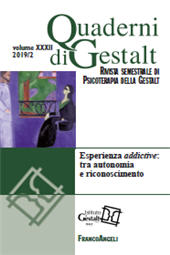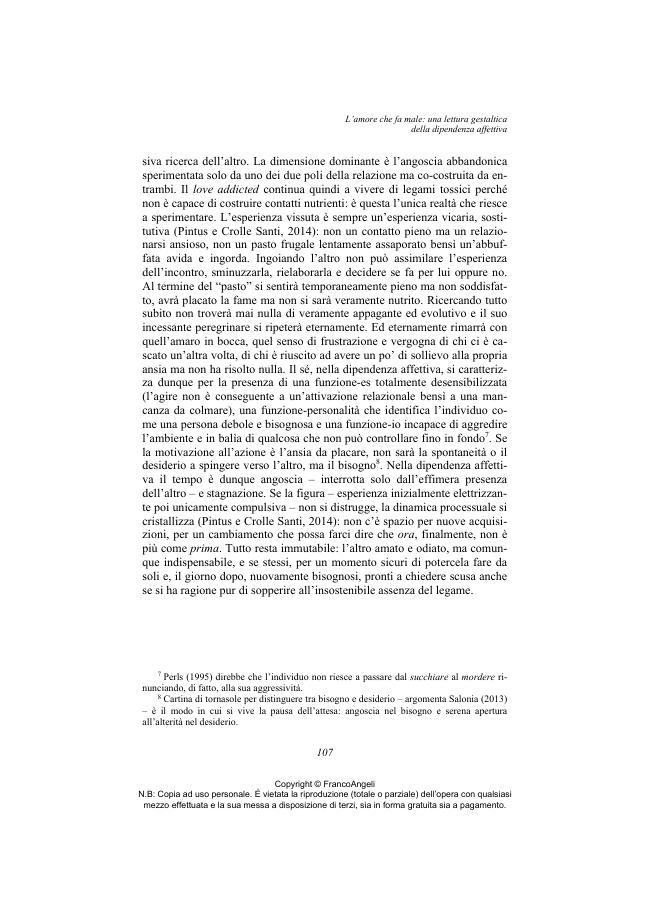L'amore che fa male : una lettura gestaltica della dipendenza affettiva
99-114 p.
L'articolo, nella sua prima parte, cerca di trovare una definizione della dipendenza affettiva, patologia così tanto presente nelle stanze dei clinici ma tuttora assente dai principali manuali diagnostici internazionali. In seguito, prova ad adattare la teoria gestaltica dell'addiction al costrutto oggetto del presente scritto. Il tentativo di trasposizione fa riferimento a diversi concetti cardine della teoria gestaltica tenendo in considerazione, in particolare, la loro declinazione da parte dell'Istituto di Gestalt HCC Italy: l'adattamento creativo, la teoria dello sviluppo polifonico dei domini, la conoscenza relazionale estetica, la dinamica figura-sfondo, la teoria del sé. Proseguendo, l'articolo delinea, sempre secondo un'ottica comparativa con la teoria gestaltica delle addiction, gli aspetti centrali del lavoro clinico gestaltico con la dipendenza affettiva. Nella parte finale, l'autore porta esempi tratti dalla sua esperienza clinica. [Testo dell'editore].
Starting from the best-seller of the American psychotherapist Robin Norwood, the article - in its first part - tries to find a definition of the concept of love addiction, a well spread suf-fering, known to psychotherapists but still absent from the main international diagnostic manuals. Borrowing the conceptualization of Reynaud et al. (2010), the present paper identifies the phenomenological-clinical and neurobiological similarities between love addiction and drug addiction, and distinguishes between a narrow view and a broad view regarding the treatment of these forms of suffering. In the second part, given the current lack of Gestalt therapy literature, the author tries to apply a Gestalt model for addictions (Pintus e Crolle Santi, 2014) to the construct of love addiction.
This attempt refers to several key concepts of Gestalt therapy and takes into account their specific declination by the Institute of Gestalt HCC Italy: creative adjustment, polyphonic development of the domains, aesthetic diagnosis, figure-ground organi-sation, theory of the self. It is agreed that, as with any other addiction, the intentionality of contact moves towards the attainment of an experience of recognition. This is even more true for love addicts, for whom we can hypothesize that their need for a totalizing and saving bond is an attempt to compensate for unsatisfactory childhood experiences characterized by the pres-ence of a caregiver not in tune with their emotional needs.
Afterwards, the paper outlines, according to a comparative perspective with the gestalt therapy theory of addiction, the crucial aspects of clinical Gestalt work with love addiction: a non-abstinent approach, the acceptance of the intentionality of contact, the restoring of the figure-ground's organisation, the resensitisation of the contact boundary and the reowning of spontaneity in contacting the environment, the construction of new and more functional creative adaptations. What has been stressed here is the importance of an aesthetic approach that captures the vitality of the cocreated figure between patient and therapist. Finally, the author brings some examples drawn from his clinical experience: Gestalt-oriented psychotherapy with men and women affected by love addiction and his experience as moderator of a virtual community of self-help for people who suffer of this pathology. [Publisher's text].
-
Articles du même numéro (disponibles individuellement)
-
Informations
Code DOI : 10.3280/GEST2019-002006
ISSN: 2035-6994
DISCIPLINES
KEYWORDS
- Dipendenze, dipendenza affettiva, adattamento creativo, dinamica figura-sfondo, sé, sviluppo polifonico dei domini, diagnosi estetica, intenzionalità di contatto, spontaneità
- Addictions, love addiction, creative adjustment, figure-ground organisation, self, polyphonic development of domains, aesthetic diagnosis, intentionality of contact, spontaneity



